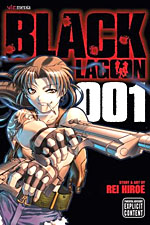 By Rei Hiroe
By Rei Hiroe
208 pages, black and white or color
Published by Viz
Don’t judge a book by its cover. We’ve all heard that adage before, but sometimes it’s hard to not do just that anyway. Well, I freely admit that sometimes I fall into that trap, too. In the case of Black Lagoon from Viz, I looked at its covers with a hot woman holding a gun on both volumes and thought to myself, "Ugh, another violent titillation comic." But a little while later my curiosity got the better of me—and boy, was I glad I gave this series a chance.
Need something retrieved, and normal channels can’t get you there? Look no further than the crew of the Black Lagoon, a team of mercenaries operating out of Thailand but found in locations all over Southeast Asia. Of course, the group just needs to survive working with each other, first. Can a clever but ethical salaryman fit in with this team?
What I found when I actually read Black Lagoon was not titillation, but instead a really high-paced action-adventure. Black Lagoon moves at a frantic speed at times, leaping from one encounter to the next in the blink of an eye. That’s a good thing, here. It means that Black Lagoon is never boring, never wasting time for anything. That’s not to say that it’s all action and nothing else, though. One of the scenes in the first two volumes that jumps out the most to me is when Rock and Revy argue about taking World War II medals from a sunken German sub that holds a painting they’ve been hired to retrieve. When Rock and Revy talk about the issue, it really stood out for me for two important things. First, that Rei Hiroe is able to bring across Revy’s existentialist views of the world without sounding preachy or bringing the story to a crashing halt. And second, that this it’s not an issue that is neatly resolved at the end of the story. In so many other series, we’d see Rock and Revy come to some sort of mutual understanding by the end of the adventure. Instead, at the end of the second volume it’s an issue that still exists between them, and if anything their problems with each other are getting worse. It’s continual change in the series, it’s an ongoing storyline, and it’s one of the things that makes me really want to read more.
The art in Black Lagoon is slick and well-composed. He draws all the main characters well, and while they’ve all got a signature look (Revy’s tank top and cut-off shorts, Rock’s white shirt and tie, and so on) he makes them always interesting to look at. Hiroe’s quite good with action sequences; characters flipping through the air or whipping around the corners just flow and move smoothly. Even a panel where Revy is blowing smoke off the muzzle of her gun is able to convey a real sense of motion, and it was at that point that I knew that Hiroe was quite the excellent artist. The biggest surprise to me, though, was that despite being in skimpy clothing, Hiroe doesn’t go for the typical choice of sexing the character up. Her cleavage is actually always under wraps, and the only place that her cut-off jean shorts actually looks sexual is on the cover of the second volume.
Hiroe’s stories in Black Lagoon are clever, fast, and fun. I’m really impressed at how well-written the stories are, in terms of both villains and missions in general. This isn’t a simple shoot-em-up, it’s an action comic for people who appreciate a smart script. I apologize, Hiroe, because I made the mistake of pre-judging your book by the cover. The reality of what’s in its pages is a genuine joy to read.
Purchase Links: Amazon.com (Vol. 1) | Amazon.com (Vol. 2)
